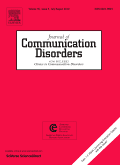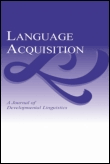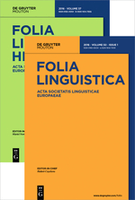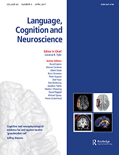
BRAIN AND LANGUAGE
Scope & Guideline
Exploring the Nexus of Cognition and Communication
Introduction
Aims and Scopes
- Neuroscience of Language Processing:
Investigates the neural mechanisms involved in language comprehension, production, and acquisition, often utilizing techniques like fMRI and EEG to understand how different brain regions interact during language tasks. - Language Disorders and Rehabilitation:
Focuses on understanding and treating language disorders such as aphasia and developmental language disorder (DLD), exploring both the underlying neural correlates and effective therapeutic interventions. - Bilingualism and Multilingualism:
Examines how bilingual and multilingual experiences shape cognitive processes, neural connectivity, and language proficiency, emphasizing the implications for education and cognitive health. - Developmental Language Studies:
Explores language acquisition and processing in children, assessing how various factors such as age, socio-economic status, and exposure to language influence developmental trajectories. - Cross-linguistic and Cultural Perspectives:
Investigates how linguistic and cultural differences impact cognitive processes, with studies often comparing native and non-native language processing and the effects of language structure on thought. - Emotional and Social Aspects of Language:
Studies the interplay between language and emotional processing, including how language influences social cognition and vice versa, often through experimental and neuroimaging methodologies.
Trending and Emerging
- Neuroplasticity and Language Recovery:
A significant increase in studies examining neuroplasticity in the context of language recovery, particularly post-stroke rehabilitation, indicates a growing interest in understanding how the brain adapts after injury. - Language Processing in Diverse Populations:
Emerging research is increasingly focused on language processing across diverse populations, including children with developmental disorders and bilingual individuals, highlighting the need for inclusive approaches in language studies. - Integration of Technology in Language Learning:
The intersection of technology and language learning, including the use of machine learning and digital tools to enhance language acquisition, is gaining traction, reflecting contemporary educational trends. - Emotional and Social Cognition in Language Use:
Research exploring the connections between emotional processing and language use is on the rise, emphasizing the importance of understanding language in social contexts and its implications for mental health. - Real-time Language Processing and Communication:
An increasing focus on real-time language processing reflects a trend towards understanding how language is dynamically produced and comprehended in social interactions, utilizing advanced neuroimaging techniques.
Declining or Waning
- Traditional Linguistic Structures:
Research focusing solely on classical linguistic theories and structures has decreased, as the journal increasingly emphasizes empirical studies and neurobiological perspectives over theoretical linguistics. - General Cognitive Psychology:
Themes related to broad cognitive psychology that do not specifically tie back to language processing are appearing less frequently, indicating a shift towards more targeted studies that directly link cognitive processes to language. - Static Models of Language Processing:
The prevalence of studies using static models of language processing has diminished, replaced by a growing interest in dynamic, interactive models that account for real-time language use and neuroplasticity. - Aging and Language without Context:
While aging and its effects on language remain relevant, there is a noticeable decline in studies that do not contextualize aging within broader cognitive or neural frameworks, reflecting a more integrative approach to understanding language across the lifespan.
Similar Journals

Linguistic Research
Exploring the Dynamics of Language and CommunicationLinguistic Research, published by the Kyung Hee University Institute for Study of Language & Information, stands as a prominent platform within the field of linguistics and language studies. With an ISSN of 1229-1374, this journal has gained recognition for its contributions to theoretical and empirical research since its inception in 2014. Ranked in the Q2 category of linguistics and language in 2023, it has established its presence in prestigious databases like Scopus, where it ranks #404 in Arts and Humanities and #479 in Social Sciences. The journal actively encourages scholarly discussion and innovation, providing a crucial venue for researchers, professionals, and students to disseminate their findings and engage in the evolving conversation around language. Despite not being open access, Linguistic Research is pivotal for those seeking comprehensive insights and advancements in linguistic studies, making it an essential resource for anyone passionate about the dynamics of language and communication.

Lingue e Linguaggio
Illuminating the Intersections of Language and SocietyLingue e Linguaggio, published by SOC ED IL MULINO, is a distinguished academic journal in the field of Linguistics and Language, hailing from Bologna, Italy. With an esteemed Q2 ranking in its category as of 2023, this journal is recognized for its contributions to both the arts and humanities as well as social sciences, achieving notable positions within Scopus rankings. It serves as a vital platform for researchers, practitioners, and students interested in exploring various linguistic phenomena, language dynamics, and theoretical frameworks. Although it operates under a traditional subscription model rather than open access, its comprehensive array of studies and publications provides significant insights and fosters academic discourse. With a publication period extending from 2002 to 2024, Lingue e Linguaggio continues to be a key resource for advancing the understanding of language in contemporary contexts.

JOURNAL OF COMMUNICATION DISORDERS
Uncovering the Complexities of Speech and Hearing.Journal of Communication Disorders (ISSN: 0021-9924; E-ISSN: 1873-7994) is a leading publication in the field of communication disorders, published by Elsevier Science Inc. With a converged publishing timeline from 1967 to 2024, this journal has established itself as a vital resource for researchers, clinicians, and educators dedicated to advancing knowledge in areas such as linguistics, language processing, speech, and hearing. It boasts an impressive reputation, ranking in the Q1 category for Linguistics and Language, and Q1 in LPN and LVN as well as Q2 in Speech and Hearing for 2023, highlighting its influence and scholarly impact within these domains. The journal is recognized for its rigorous peer-reviewed articles and its contributions to our understanding of cognitive neuroscience, experimental psychology, and communication disorders—further evidenced by its ranking in the top percentiles in various fields. Although it does not currently offer Open Access options, readers and contributors alike will appreciate the depth and breadth of research published within its pages. This journal serves an essential role in bridging the gap between research and practical application, making it a must-read for anyone involved in the study or treatment of communication disorders.

Frontiers in Human Neuroscience
Connecting Minds: Where Neuroscience Meets Behavioral ScienceFrontiers in Human Neuroscience is a premier open access journal published by FRONTIERS MEDIA SA, dedicated to advancing the understanding of the complexities of human neuroscience. With an ISSN of 1662-5161, the journal has established its prominence in various fields, achieving a Q2 ranking in categories such as Behavioral Neuroscience, Neuropsychology and Physiological Psychology, and Psychiatry and Mental Health as of 2023. Since its inception in 2008, Frontiers in Human Neuroscience has consistently contributed to the scholarly dialogue by offering a platform for innovative research that bridges the gap between neuroscience and behavioral science. The journal's rigorous peer-review process and commitment to open access ensures that findings are readily available, promoting collaboration and progress within the academic community. With an impact on neuroscience disciplines, it stands at the forefront of the field, inviting researchers, professionals, and students alike to engage with cutting-edge studies and developments. The journal's address is located in Lausanne, Switzerland, where it continues to flourish as a hub for neurobiological exploration.

Rivista di Psicolinguistica Applicata-Journal of Applied Psycholinguistics
Empowering Research in Language and Psychology.Rivista di Psicolinguistica Applicata - Journal of Applied Psycholinguistics is a distinguished journal dedicated to exploring the intersections of psychology and linguistics, making significant contributions across various subfields of psycholinguistics and its applications. Published by Fabrizio Serra Editore in Italy, this journal presents a repository of innovative research, theoretical advancements, and practical applications relevant to developmental and educational psychology, linguistics, and social psychology. Although currently listed in Q4 for Developmental and Educational Psychology and Q4 for Social Psychology, the journal has achieved a respectable Q3 ranking in Linguistics and Language, reflecting its commitment to enhancing understanding within these realms. With an E-ISSN of 1724-0646, the journal facilitates accessibility to its content, empowering scholars and practitioners to stay abreast of emerging trends and findings. The impact factor of the journal is poised for growth as it seeks to amplify its reach and influence within the academic community, appealing to researchers, professionals, and students who have a vested interest in the dynamic field of applied psycholinguistics.

Language Acquisition
Fostering interdisciplinary insights into language development.Language Acquisition, published by ROUTLEDGE JOURNALS, TAYLOR & FRANCIS LTD, is a leading academic journal dedicated to the interdisciplinary study of language development and acquisition. With an ISSN of 1048-9223 and E-ISSN 1532-7817, this peer-reviewed journal caters to professionals, researchers, and graduate students in the fields of linguistics and educational psychology. The journal boasts an impressive 2023 Scopus ranking of Q1 in Linguistics and Language and Q2 in Education, reflecting its high impact and relevance within academic circles. Notably, it is indexed among the top 15% of journals in Language and Linguistics, showcasing its significance in contributing knowledge to these vibrant fields. Although currently not open access, Language Acquisition makes a profound impact on understanding how individuals acquire language, facilitating discussions on pedagogical strategies, cognitive development, and sociolinguistic factors. The journal's historical and ongoing contributions since its inception in 1990 reinforce its position as a vital resource for advancing research and theory related to language acquisition.

FOLIA LINGUISTICA
Pioneering Research at the Forefront of LinguisticsFOLIA LINGUISTICA, published by WALTER DE GRUYTER GMBH, is a premier scholarly journal dedicated to the field of linguistics. Established in 1967, the journal has consistently provided a platform for innovative research and scholarly discourse in language and linguistics, contributing significantly to the academic community's understanding of language structures, usage, and cognitive processes. With its classification in the top quartile (Q1) of linguistics and language in 2023, FOLIA LINGUISTICA holds a respectable rank (#282/1088) within the Arts and Humanities category and an admirable percentile rank of 74th, ensuring its position at the forefront of linguistic scholarship. Researchers and academics from around the globe can access a wealth of knowledge and cutting-edge research findings through this esteemed publication, which is vital for anyone looking to engage with the latest advancements in linguistics. Located in Berlin, Germany, FOLIA LINGUISTICA encompasses all aspects of language research, making it an indispensable resource for researchers, professionals, and students alike seeking to deepen their understanding of language and its complexities.

LANGUAGE SCIENCES
Championing Cutting-Edge Linguistic DiscoveriesLANGUAGE SCIENCES, published by Elsevier Science Ltd, stands as a prominent journal in the field of linguistics and language studies. With an impressive impact factor that solidifies its reputation, it holds a Q1 ranking in both the linguistics and language categories for 2023, reflecting its excellence and relevance in cutting-edge research. Since its inception in 1979, this journal has evolved to encompass a wide range of interdisciplinary studies, providing a platform for innovative research that addresses the complexities of language use, acquisition, cognition, and social interactions. The journal is hosted in the United Kingdom and features rigorous peer-reviewed articles that contribute significantly to both the academic community and practical applications in language-related fields. With access options tailored for a diverse range of readers and contributors, LANGUAGE SCIENCES invites scholars, students, and professionals to engage with its comprehensive body of work and contribute to the ongoing discourse in linguistics.

Language Cognition and Neuroscience
Advancing Knowledge at the Intersection of Cognition and LanguageLanguage Cognition and Neuroscience is a premier peer-reviewed journal published by ROUTLEDGE JOURNALS, TAYLOR & FRANCIS LTD, focusing on the intersection of linguistics, cognitive psychology, and neuroscience. Since its inception in 2013, this journal has established itself as a vital resource for researchers and scholars, contributing significantly to the understanding of how language is processed and represented in the brain. With its impressive rankings in various categories—Q1 in Linguistics and Language, Q2 in Cognitive Neuroscience, and Experimental and Cognitive Psychology—it caters to a diverse and interdisciplinary audience. The journal is accessible to readers worldwide, effectively communicating cutting-edge research and innovative methodologies in the field. Open Access options enable broader disseminations of knowledge, ensuring that significant findings reach both academic and practical applications. With a commitment to high-quality research, Language Cognition and Neuroscience continues to be an influential platform for advancing theories and practices within cognitive science and language studies.

Languages
Exploring the rich tapestry of language and its applications.Languages, published by MDPI, is a prestigious open-access journal dedicated to the field of Linguistics and Language studies. Since its inception in 2016, this journal has rapidly established itself as a leading platform for high-quality research, achieving an impressive Q1 ranking in 2023 and standing out in both the Arts and Humanities as well as the Social Sciences categories with significant percentile rankings (76th and 74th respectively). Based in Switzerland, Languages fosters an international community of scholars who are committed to exploring the multifaceted dimensions of language, from theoretical frameworks to practical applications. With a robust e-ISSN of 2226-471X, the journal prioritizes accessibility, allowing researchers, professionals, and students to freely engage with cutting-edge research and insights. By bridging the gap between theory and practice, Languages plays a crucial role in advancing our understanding of linguistic phenomena, making it an invaluable resource for anyone invested in the study of language.